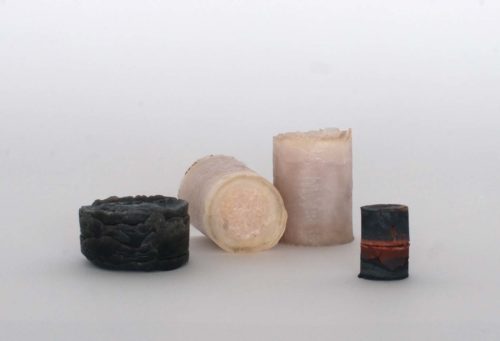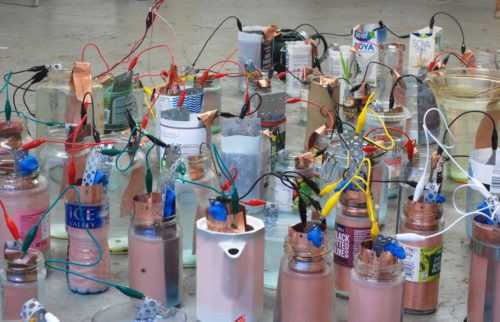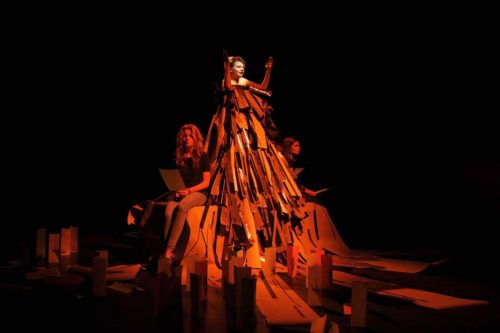The overarching theme of this year’s Wonder Women radical feminist festival in Manchester has to do with women’s representation and influence in our political and cultural institutions, responding to the centenary of the Representation of the People Act. 1918 was the first time that any women were able to vote in Britain, but as we must be careful to acknowledge, it was only property-owning women over thirty who were granted this basic right with the act. As such, it is important to commemorate and respond with nuance, something that the research-lead art practices of Hannah Leighton-Boyce and Ruth Barker are able to do by virtue of their methods and structure. As part of the festival, Leighton-Boyce and Barker have been commissioned to produce new bodies of work to be presented in a two-person exhibition at Castlefield Gallery, part of the gallery’s long-running ‘head to head’ series, whereby two artists whose work corresponds are placed in juxtaposition. Over the past year, both artists have been supported in conducting research residencies, allowing for the time and space to become embedded within their respective institutions and communities, and to explore unanticipated avenues.
Barker, usually based in Glasgow, was working with Salford University and its art collection, whereas Leighton-Boyce, a Manchester based artist, has been in residence at the Glasgow Women’s Library. The Salford University collection is a remarkable resource, comprising works of Chinese contemporary art, artists’ film and prints amongst much more — at a time when many public collections are being plundered in order to plug the deficits created by austerity measures. The Glasgow Women’s Library, on the other hand, is an equally vital resource as the only accredited museum in the UK dedicated to women’s histories, functioning as a counteraction to the patriarchally and colonially influenced collections of the majority of the UK’s museums and libraries. The distinctive nature of the two collections is relevant in considering the work that each artist has produced. Both Leighton-Boyce and Barker have approached broad, familiar themes and near-universal symbols, and yet their work can simultaneously be understood in terms of the personal and particular. Comparably, a university art collection wouldn’t always have been unusual, and one that still collects is sadly exceptional, whereas women’s histories are obviously intrinsic to history in general, but have had to be set apart in their own library due to omission.
It is also relevant here to draw attention and to question the cliched, if not purposefully antagonistic, ways in which women’s artistic and literary production is often defined as confessional and intimate. This tendency is interesting to consider in the context of both Leighton-Boyce and Barker’s practices as well as the wider Wonder Women festival in general. With both artists, their new bodies of work are interpreted using reference to recent personal experiences, but deal with themes that are archetypal and mythic, and as such needn’t necessarily be framed in these terms in order to be meaningful and effective. The impulse to require confessional intimacy from those who have been historically underrepresented, as though by taking so much from a few it will make up for previous exclusions, is one that this exhibition and the wider festival offer an opportunity to scrutinise and unpick. As previously alluded to, this centenary is promoted as an opportunity to celebrate the achievements of the Suffragettes, but in gaining a vote and a voice for some, many were still excluded. This has edged the commemorations so far with a justified bitterness, and so in questioning how we can shape the future of Manchester and support women’s struggles the world over, it is imperative to admit discourse and critique.
Within this context, in which the way things ought to be with regards to equal representation are not reflected in the way they are, and idealistic tendencies bump up against pragmatism, research-driven art practices are especially relevant and useful. Leighton-Boyce described how in working with an archive she had imagined finding some specific document or figure to focus on, but whilst in residency at Glasgow Women’s Library was instead drawn intuitively to widely resonant objects and themes, whereas Barker’s work has ostensibly grown out of her own experience of Motherhood, but is also richly informed by philosophy and theory that deals comprehensively with the psychoanalytic notion of the mother and femininity, as well as voice and kinship. In an era characterised by bubbles of agreement and influence, when the purported proof offered by statistics can clearly be manipulated to suit ideologies and agendas, it seems that the forms of research afforded by artistic practice can be effective in a way that quantitative research is not. As Graeme Sullivan contends: “If a measure of the value of research is seen to be the capacity to create new knowledge and understanding that is individually and culturally transformative, then criteria need to move beyond probability and plausibility to possibility.”
Although at the time of writing the exhibition in question has yet to take place, from brief conversations with and research around the practices of both artists, some fascinating linkages have emerged that hark back to classical and biblical representations of womanhood whilst bearing witness to, and critiquing, the present. This simultaneous ability to draw from the past whilst scrutinising current and future possibilities is epitomised by two female characters from western cultural history whose stories coalesce around a supposed infraction that doomed them: Eurydice and the wife of Lot. In the case of Eurydice, the infraction was not hers, but it was still the act of turning and looking back by Orpheus that sent her to the underworld, whereas for Lot’s unnamed wife, her own inability or refusal to follow a command not to turn had her transformed into a pillar of salt. Barker has referenced Kaja Silverman as an influence on her thinking, and in the introduction to ‘Flesh of my Flesh’ (2009), Silverman speaks of Eurydice and the idea of turning back and of claiming what or who went before us: “If we are able to see the parallels between what they did and what we are doing, we will not only prevent a new catastrophe from occurring, but also change the ‘character of the past’. ”
In the work that she has produced towards the Castlefield exhibition, Barker does not explicitly point to the aforementioned references, but will include an image of Ishtar, the Mesopotamian goddess who, unlike Eurydice, escaped the underworld and left her husband in her place. The image of the goddess is a child’s drawing, that will be made into a rug at Salford University’s fibre workshop by artists’ assistant Alena Donely. This is a relevant detail due to the way in which Barker has brought collaborators and the expertise of others into this body of work, which has been described as responding to a loss of voice triggered by traumatic birth experience and the general conditions in British society. This is indicative of the way that the artist views collaboration and kinship as a way to communicate more broadly, rather than as a dilution of her authorship. On this topic Barker refers to Silverman’s contention that human beings are not autonomous, but rather exist within a web of connections, and the philosopher Mary Midgley who has written extensively on the sociality of selfhood. As Barker also notes, both of these stances are at odds with the traditional concept of the solitary artist that, despite denunciations, still holds sway along with the characters of Orpheus and Lot, one of whom is punished for turning and ostracises himself as a result, and the other who forges onward without hindsight.
For Leighton-Boyce the unnamed Lot’s wife is central, both in terms of her weary anonymity and her transformation into the symbolically rich substance of salt. The artist highlights ways that salt has played an active role in human history, as a currency, a tool of oppression, a method of food preservation and of healing; whilst on a molecular level, it splits in water, dissolving and disappearing to the naked eye. This substance epitomises the energy and contradiction of division and attraction for Leighton-Boyce. The artist’s other research focus, the round table, is similarly familiar and yet marked by historical specificity, representing a communal rejection of hierarchy but also having been used by specific figures and in specific contexts. Leighton-Boyce describes being drawn to the round table at The Glasgow Women’s Library, later discovering another round table at The Pankhurst Centre in Manchester that had been used for Suffragette meetings and the ‘Table of Sentiments’ from the first convention of women’s rights in Seneca Falls, New York. In its evocation here, the round table emphasises how the symbols and structures of equality and egality, whilst powerful and worthwhile, can also be used to reproduce hierarchies.
Launched on International Women’s Day, March 8th, it will be fascinating to observe how the interplay between specificity and universality in the work of Barker and Leighton-Boyce may influence the character of the Wonder Women festival. The commemorations for 1918 have already been marred by governmental incompetence , leaving just four days for community groups to apply to fund their projects, which is a detail reminiscent of Barker’s assertion that the economic conditions of contemporary Britain are coalescing with other factors to render her publically mute. Therefore it is imperative to consider these two bodies of work, alongside the wider discourse around 1918 and contemporary feminism, as part of a complex network of community and kinship where the research and work is ongoing, but looking back, claiming what went before and reckoning with history is just as important.
This article was commissioned by Alexandra Arts for the special print edition of Art 511 Mag celebrating International Women’s Day and the centenary for UK women’s suffrage [funded by ARTS COUNCIL ENGLAND] during the Pankhurst in the Park 2018 season.


